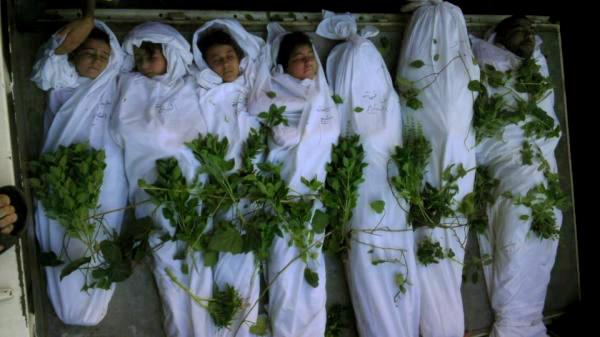
Some of the dead from the Darayya mass killing, August 2012
Phil Sands writes for The National:
Chickens once more turn on spits outside of Abu Kamal's, a restaurant in the centre of town and a local landmark of sorts, known for its mediocre but filling fast food.
People slowly walk in the streets, small general stores are open and some of the town's furniture makers are busy again in their small workshops, sawdust drifting out on to the roads.
It has been more than six weeks since Daraya suffered the bloodiest single massacre of the Syrian uprising, and daily life has resumed.
On the surface, little appears to have changed since the time before that bright and breezy Friday in late August, when, after a sustained artillery bombardment, tanks and ground troops moved into central Daraya and killed hundreds, perhaps a thousand, people. Men, women and children died, most of them shot.
Today, there are few overt reminders of the terror and bloodshed that ensued that day.
A car crushed by a tank stands on the side of the road. The metal shutters of shopfronts are twisted and blasted full of holes. Some cinder-block buildings bear the scars of tank fire.
Yet deeper, in the minds of its residents, Daraya is utterly changed.
"When you're out, you see people and look at their faces and maybe you think they are OK. They are pretending. Now in Daraya, people pretend to be living normal lives," said a town resident in his early 20s who is engaged to be married.
"After what happened, everyone is haunted. When you are alone, when you go to sleep at night, you cry," he said.
Chastened by the military assault - it is often referred to locally as "the scare" or "the terror" - people are still struggling to come to terms with what took place and are petrified it could happen again
Daraya's once resolute defiance of the regime - in which thousands protesting stoically, and even optimistically, endured months of shootings, mortar fire and strafing by helicopter gunships - has been profoundly shaken. It is a town still in shock.
If the goal of the assault was to make clear that continued dissent would come at a very high cost, it left no room for doubt.
"The regime had a big success with the operation. It terrified people to the extent that protests have been hard to organise now," said one leading campaigner in the town.
* * * * *
Before the raid, Daraya, a moderately wealthy town of 200,000 to 250,000 people - mainly Sunni Muslims, but with a Christian minority - was being administered with quiet efficiency by community volunteers and by a handful of local municipal officials, turning up for work out of habit. It was an undeclared liberated zone, free from government forces.
But it did not go unnoticed strategically. It is only six kilometres from the upmarket Mezze district of Damascus and adjoins Mezze Airport, a vital military facility that Daraya's rebels, growing in strength, were poised to strike.
So while few people were surprised at the fact of the late summer onslaught, its ferocity and magnitude took them aback, even in a country where atrocities and killing have become commonplace.
Before the events of August 24, the massacre of 220 people in Tremseh, in central Hama, had been the conflict's bloodiest single reported episode.
"The regime wanted to send a message that there will be huge price for defying it in Damascus, that is why it was so savage here. It was telling the people, 'If you choose the path of revolution, this is what will happen to you'," the activist said.
Underscoring their point, troops who swept through Daraya's streets wrote on walls "Assad or No One".